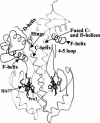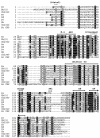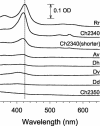Functionally critical elements of CooA-related CO sensors
- PMID: 14973040
- PMCID: PMC344431
- DOI: 10.1128/JB.186.5.1320-1329.2004
Functionally critical elements of CooA-related CO sensors
Abstract
CooA is a heme-containing transcriptional activator that enables Rhodospirillum rubrum to sense and grow on CO as a sole energy source. We have identified a number of CooA homologs through database searches, expressed these heterologously in Escherichia coli, and monitored their ability to respond to CO in vivo. Further in vitro analysis of two CooA homologs from Azotobacter vinelandii and Carboxydothermus hydrogenoformans corroborated the in vivo data by revealing the ability of CO to bind to these hemoproteins and stimulate their binding at specific DNA sequences. These data, as well as the patterns of conserved residues in the homologs, are compared to what is already known about functionally important residues in the CooA protein of R. rubrum. The results identify critical regions of CooA and indicate features that distinguish CooAs from the general family of cyclic AMP receptor proteins.
Figures





Similar articles
-
Carbon monoxide-induced activation of gene expression in Rhodospirillum rubrum requires the product of cooA, a member of the cyclic AMP receptor protein family of transcriptional regulators.J Bacteriol. 1995 Apr;177(8):2157-63. doi: 10.1128/jb.177.8.2157-2163.1995. J Bacteriol. 1995. PMID: 7721706 Free PMC article.
-
Recognition of target DNA and transcription activation by the CO-sensing transcriptional activator CooA.Biochem Biophys Res Commun. 1999 Aug 2;261(2):270-5. doi: 10.1006/bbrc.1999.1046. Biochem Biophys Res Commun. 1999. PMID: 10425177
-
A novel heme protein that acts as a carbon monoxide-dependent transcriptional activator in Rhodospirillum rubrum.Biochem Biophys Res Commun. 1996 Nov 21;228(3):752-6. doi: 10.1006/bbrc.1996.1727. Biochem Biophys Res Commun. 1996. PMID: 8941349
-
CO sensing and regulation of gene expression by the transcriptional activator CooA.J Inorg Biochem. 2000 Nov;82(1-4):51-6. doi: 10.1016/s0162-0134(00)00139-2. J Inorg Biochem. 2000. PMID: 11132638 Review.
-
Biochemical and biophysical properties of the CO-sensing transcriptional activator CooA.Acc Chem Res. 2003 Nov;36(11):825-31. doi: 10.1021/ar020097p. Acc Chem Res. 2003. PMID: 14622029 Review.
Cited by
-
Spectroscopic Interrogation of Thiolate Hydrogen Bonding in the CO Sensor Protein CooA: Implications for Thiolate Ligation Stability and Cytochrome P450 Function.Chemistry. 2025 Jul 2;31(37):e202404504. doi: 10.1002/chem.202404504. Epub 2025 Jun 8. Chemistry. 2025. PMID: 40397461 Free PMC article.
-
Effect of DNA binding on geminate CO recombination kinetics in CO-sensing transcription factor CooA.J Biol Chem. 2012 Jun 22;287(26):21729-40. doi: 10.1074/jbc.M112.345090. Epub 2012 Apr 28. J Biol Chem. 2012. PMID: 22544803 Free PMC article.
-
Mycobacterium tuberculosis senses host-derived carbon monoxide during macrophage infection.Cell Host Microbe. 2008 May 15;3(5):323-30. doi: 10.1016/j.chom.2008.03.007. Cell Host Microbe. 2008. PMID: 18474359 Free PMC article.
-
Metal centers in the anaerobic microbial metabolism of CO and CO2.Metallomics. 2011 Aug;3(8):797-815. doi: 10.1039/c1mt00042j. Epub 2011 Jun 6. Metallomics. 2011. PMID: 21647480 Free PMC article. Review.
-
Site-directed spin label electron paramagnetic resonance spectroscopy as a probe of conformational dynamics in the Fe(III) "locked-off" state of the CO-sensing transcription factor CooA.Protein Sci. 2018 Sep;27(9):1670-1679. doi: 10.1002/pro.3449. Protein Sci. 2018. PMID: 30168206 Free PMC article.
References
-
- Aono, S., K. Ohkubo, T. Matsuo, and H. Nakajima. 1998. Redox-controlled ligand exchange of the heme in the CO-sensing transcriptional activator CooA. J. Biol. Chem. 273:25757-25764. - PubMed
-
- Boehning, D., and S. H. Snyder. 2003. Novel neural modulators. Annu. Rev. Neurosci. 26:105-131. - PubMed
-
- Coyle, C. M., M. Puranik, H. Youn, S. B. Nielsen, R. D. Williams, R. L. Kerby, G. P. Roberts, and T. G. Spiro. 2003. Activation mechanism of the CO sensor CooA: mutational and resonance Raman spectroscopic studies. J. Biol. Chem. 278:35384-35393. - PubMed
-
- Dobbek, H., V. Svetlitchnyi, L. Gremer, R. Huber, and O. Meyer. 2001. Crystal structure of a carbon monoxide dehydrogenase reveals a [Ni-4Fe-5S] cluster. Science 293:1281-1285. - PubMed
Publication types
MeSH terms
Substances
Grants and funding
LinkOut - more resources
Full Text Sources

